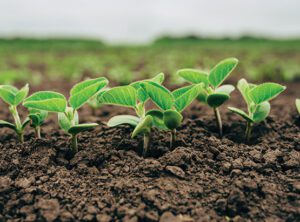Forty-year farmer and Marine veteran Gary Rademacher never stops improving. When he first started farming near Holdingford, Minnesota in the 1970s, 100-bushel corn yields and 40-bushel soybean yields were the status-quo. “Those were bar-stool yields,” said Rademacher, “yields you could go into town and be proud of.”
Rademacher’s farm has come a long way in the past 40 years. Today, he averages 200-bushel corn and 66-bushel soybeans in the short Minnesota growing season. “If you always do everything the same, you’ll get the same yields. We always go for more and never give up,” said Rademacher.
“With the help of my two sons and five grandsons, we operate about 550 acres of mostly corn and soybeans,” said Rademacher. A former dairy farmer and genetics expert, Rademacher sold his herd of registered Holsteins just five years ago. “We used to grow much more alfalfa when we operated Heavens View Farms. We exported embryos all over — China, England, France, Holland — and had about 350 to 400 head at any given time.”
Rademacher attributes much of his success to advancements in ag technology and his 15-year partnership with Midwestern BioAg consultant Mike Lovlien. “I wish I had worked with Mike from the very beginning. BioAg has been instrumental in taking my crop production to the next level.”
In some areas, Rademacher has achieved 230-bushel corn yields using just 130 pounds of nitrogen.
Boosting Nitrogen Efficiency
Working with Lovlien, Rademacher has topped county yields with fertilizer blends designed to support his soil. “Gary applied a 8-18-15-9S starter with high traces to his corn and soybeans this year,” said Lovlien. Rademacher applied the fertilizer in-furrow at 275 pounds per acre on his corn and 180 pounds per acre on beans.
When his corn reached the V6 growth stage, Rademacher made a second pass with 32% nitrogen and L-CBF BOOST™ liquid fertilizer at a 10 percent inclusion rate. “Gary was really impressed with his corn crop this year,” said Lovlien. “In areas where Boost was applied, Gary saw significant results — about an 18 bushel-per-acre increase.”
Made with pure sugar cane molasses, L-CBF delivers plant nutrients in a carbon base to stimulate soil biology and increase nutrient availability. “My sense is that BOOST played a role in keeping nitrogen available to support late-season growth,” said Rademacher. “With $3 corn, we can’t afford to lose any.”
Rademacher saw results from BOOST all season. “Plants this year were extremely healthy, despite the wet year. Standability was excellent, root structures were strong and fields were very uniform. A few of my neighbors also applied BOOST this year and you could see the difference from the road. Next year, we plan to double our BOOST inclusion rate on low-fertility fields. It does just what Mike said it would — it’s like it just woke up the soil.”
In some areas, Rademacher has achieved 230-bushel corn yields using just 130 pounds of nitrogen. “Mike has helped us come a long way with our fertilizer program,” said Rademacher. “He’s really helped us keep nitrogen application timely and efficient.”
Cover Crop Success
For the past eight years, Rademacher has followed fall harvest with cover crops whenever possible. He’s experimented with rye, clover, oats, and tillage radish. “We’ve had phenomenal success with rye,” said Rademacher. “There are so many benefits to cover crops, but it does take a bit of learning and adjustment.” Rademacher recommends farmers plant as early as possible to build in time for cover crop establishment later in the season.
“We like to follow soybeans with rye in the fall,” said Rademacher. “In the spring, we terminate the rye after 4 to 6 inches of regrowth, disc it in after about 48 hours, and then use a regular seed drill to plant corn. Planting rye after beans helps capture nitrogen and keeps it from leaching over winter.”
Rademacher focuses on planting cover crops on erodible acres first to help keep topsoil intact. “I’ve worked with the Environmental Quality Incentives Program (EQIP) to help recoup some of the extra costs of cover crops.” Sponsored by the NRCS, EQIP provides financial assistance to help plan and implement conservation practices that address natural resource concerns and improve soil, water, plant, animal, air and related resources on agricultural land.
“Cover crops have helped improve my fertilizer efficiency and break the cycle of insect pressure,” noted Rademacher. “My soils have improved and my plants show it. Seed emergence is better, and my soil is much more crumbly. Biological activity is up, and I now have that ‘chocolate cake’ soil Gary Zimmer is always talking about.”
Rademacher also works with the Minnesota Agricultural Water Quality Certification Program (MAWQCP), an initiative designed to help farmers take the lead in implementing water conservation practices. “We are in the process of becoming MAWQCP certified,” said Rademacher. “The things we do to promote soil health on our farm also protect water quality. It’s win-win for stewardship and profitability.”
By focusing on soil health, Rademacher has also seen residue decomposition rates increase. His crops have benefited from the increased organic matter and the biological activity in his soils.
“When I added cover crops into my rotation, rootworm and aphid issues declined,” said Rademacher. “Farmers pay about $30 extra a unit for rootworm protection. I no longer buy that trait for corn following rye because I haven’t needed it. I can’t say for certain I’ll never have rootworm issues again, but by the looks of my plants today, I don’t need it.”
Rademacher’s goal is to leave his soil in better condition than when he first started farming 40 years ago. He has no plan to stop improving any time soon. “I don’t plan on getting old too soon,” said Rademacher. “It’s just starting to get fun!”

